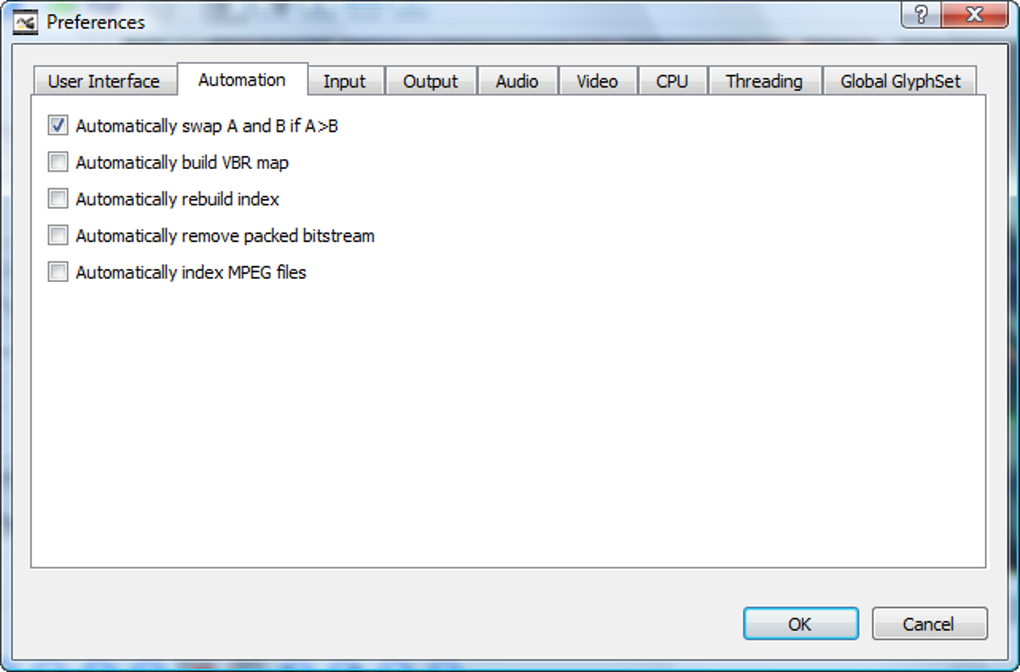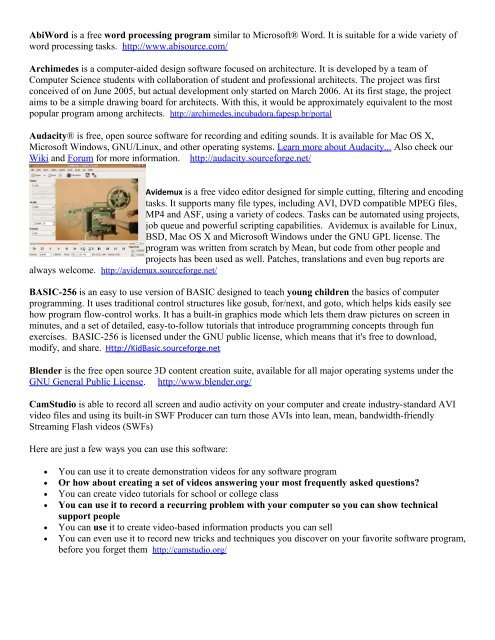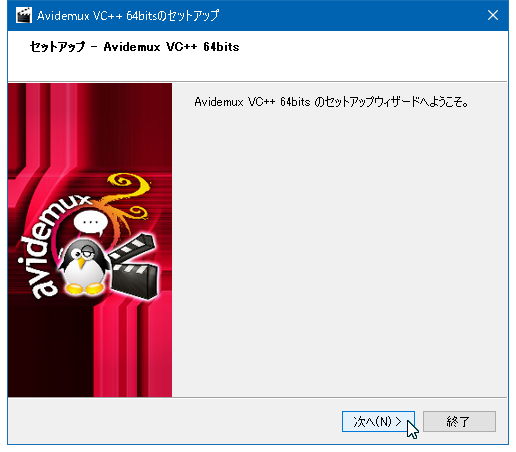| Developer(s) | 'Mean', 'Gruntster' and 'Fahr'[1] |
|---|---|
| Stable release | 2.7.8 (9 March 2021; 2 months ago[2]) [±] |
| Preview release | None [±] |
| Repository | |
| Written in | C++ |
| Operating system | Windows, OS X, Linux, BSD |
| Platform | IA-32 and x64 |
| Available in | English, Czech, French, Italian and German |
| Type | Video editing software |
| License | GNU General Public License |
| Website | avidemux.org |
Avidemux is a free and open-source software for non-linear video editing and transcoding multimedia files. The developers intend it as 'a simple tool for simple video processing tasks' and to allow users 'to do elementary things in a very straightforward way'.[3] It is written in C++ and uses Qt for its graphical user interface, and FFmpeg for its multimedia functions. Starting with version 2.4, Avidemux also offers a command-line interface, and since version 2.6, the original GTK port has not been maintained and is now discontinued.
- We would like to show you a description here but the site won't allow us.
- Calling avidemux from command line. Fixing mpeg4 files so they play on standalone NEW. Capture to SVCD.
Nightly automated builds available on avidemux.org. Sourceforge mirror. In particular, it means you cannot alter/replace the installer to bundle avidemux with other programs (for example: browser toolbars). Doing so would invalidate your license to redistribute and you would be. If you wish to open Avidemux now then leave the top option checked. The second option will (perhaps a little annoyingly) pop up a browser window infront of Avidemux. Perhaps best to uncheck the last option and press 'Finish' and Avidemux should appear in front of you.
Avidemux is developed for Linux, macOS, and Windows. Unofficial builds are also available for FreeBSD, NetBSD, and OpenBSD.[4][5][6]
Features[edit]
Avidemux is capable of non-linear video editing, applying visual effects (called 'Filters' by Avidemux) to video, and transcoding video into various formats. Some of the filters were ported from MPlayer and Avisynth. Avidemux can also insert audio streams into a video file (an action known as multiplexing or 'muxing') or extract audio streams from video files (an action known as 'demuxing').
An integral and important part of the design of the program is its project system, which uses the SpiderMonkey JavaScript engine. Whole projects with all options, configurations, selections, and preferences can be saved into a project file. Like VirtualDub's VCF scripting capabilities, Avidemux has advanced scripting available for it both in its GUI and command line modes. It also supports a non-project system just like VirtualDub, where users can simply create all of their configurations and save the video directly without making a project file. A project queue system is also available.
Avidemux has built-in subtitle processing, both for optical character recognition of DVD subtitles and for rendering hard subtitles. Avidemux supports various subtitle formats, including MicroDVD (.SUB), SubStation Alpha (.SSA), Advanced SubStation Alpha (.ASS) and SubRip (.SRT).
Components[edit]
Avidemux was written from scratch, but additional code from FFmpeg, MPlayer, Transcode and Avisynth has been used on occasion as well. Nonetheless it is a completely standalone program that does not require any other programs to read, decode, or encode other than itself. The built-in libavcodec library from the FFmpeg project is used for decoding and encoding of various audio and video formats such as MPEG-4 ASP. The primary (though not the only) Avidemux programmer uses the nickname 'Mean' on the Avidemux forum.[7]
Multithreading[edit]
Multithreading has been implemented in the following areas of Avidemux (some partially through libavcodec):
- Encoding
- MPEG-1 and MPEG-2 (using libavcodec)
- MPEG-4 Part 2 SP/ASP (using libavcodec or Xvid)
- Earlier versions of Xvid are not compatible with this feature.
- H.264/MPEG-4 Part 10 AVC (using x264)
- H.265/HEVC (using x265)
- Decoding
- MPEG-1 and MPEG-2 (using libavcodec)
- MPEG-4 Part 2 SP/ASP (using libavcodec)
Supported formats[edit]
Avidemux supports following file formats:


| Name | File extension | As input | As output |
|---|---|---|---|
| Audio Video Interleave | .AVI | Yes | Yes |
| Advanced Systems Format | .ASF, .WMV and .WMA | Yes | No |
| Flash Video | .FLV | Yes | Yes |
| Matroska | .MKV | Yes | Yes |
| MPEG elementary stream | N/A | Yes | No |
| MPEG program stream | .MPG and .MPEG | Yes | Yes[a] |
| MPEG transport stream | .TS | Yes | Yes |
| MPEG-4 Part 14 | .MP4 | Yes | Yes |
| NuppelVideo | .NUV | Yes | No |
| OGM | .OGM | Yes | Yes |
| QuickTime | .MOV | Yes | No |
| 3GP | .3GP | Yes | No |
| DVD-Video | .VOB | Yes | Yes |
| WebM | .WebM | Yes | Yes |
| Name | As input | As output |
|---|---|---|
| AV1 | Yes[b] | No |
| Cinepak | Yes | No |
| DV | Yes | Yes |
| FFV1 | Yes | Yes |
| H.263 | Yes | Yes |
| H.264/MPEG-4 Part 10 AVC | Yes | Yes[c] |
| H.265/HEVC | Yes | Yes[d] |
| HuffYUV | Yes | Yes |
| MPEG-1 | Yes | Yes |
| MPEG-2 | Yes | Yes |
| MPEG-4 Part 2[e] | Yes[f] | Yes[g] |
| Motion JPEG | Yes | Yes |
| MSMPEG-4 v2[h] | Yes | No |
| Raw video – RGB | Yes | No |
| Raw video – YV12 | Yes | Yes |
| Snow | No | Yes |
| Sorenson Video 3 (SVQ3) | Yes | Yes |
| VC-1[i] | Yes | No |
| VP3 | Yes | No |
| VP6 | Yes[j] | No |
| VP8 | Yes[j] | No |
| VP9 | Yes[j] | Yes[k] |
| Windows Media Video 8[l] | Yes | No |
| Y800 | Yes | Yes |

| Name | As input | As output |
|---|---|---|
| Adaptive Multi-Rate – Narrow Band (AMR-NB) | Yes | No |
| Advanced Audio Coding (AAC) | Yes | Yes |
| AC-3 | Yes | Yes |
| DTS | Yes | No |
| Linear pulse-code modulation (LPCM) | No | Yes |
| MP2 | Yes | Yes |
| MP3 | Yes | Yes |
| Opus | Yes | Yes |
| Pulse-code modulation (PCM) | No | Yes |
| Vorbis | Yes | Yes |
| Name | File extension | As input | As output |
|---|---|---|---|
| Windows bitmap | .BMP | Yes | No |
| JPEG | .JPG and .JPEG | Yes | No |
See also[edit]
Notes[edit]

Features[edit]
Avidemux is capable of non-linear video editing, applying visual effects (called 'Filters' by Avidemux) to video, and transcoding video into various formats. Some of the filters were ported from MPlayer and Avisynth. Avidemux can also insert audio streams into a video file (an action known as multiplexing or 'muxing') or extract audio streams from video files (an action known as 'demuxing').
An integral and important part of the design of the program is its project system, which uses the SpiderMonkey JavaScript engine. Whole projects with all options, configurations, selections, and preferences can be saved into a project file. Like VirtualDub's VCF scripting capabilities, Avidemux has advanced scripting available for it both in its GUI and command line modes. It also supports a non-project system just like VirtualDub, where users can simply create all of their configurations and save the video directly without making a project file. A project queue system is also available.
Avidemux has built-in subtitle processing, both for optical character recognition of DVD subtitles and for rendering hard subtitles. Avidemux supports various subtitle formats, including MicroDVD (.SUB), SubStation Alpha (.SSA), Advanced SubStation Alpha (.ASS) and SubRip (.SRT).
Components[edit]
Avidemux was written from scratch, but additional code from FFmpeg, MPlayer, Transcode and Avisynth has been used on occasion as well. Nonetheless it is a completely standalone program that does not require any other programs to read, decode, or encode other than itself. The built-in libavcodec library from the FFmpeg project is used for decoding and encoding of various audio and video formats such as MPEG-4 ASP. The primary (though not the only) Avidemux programmer uses the nickname 'Mean' on the Avidemux forum.[7]
Multithreading[edit]
Multithreading has been implemented in the following areas of Avidemux (some partially through libavcodec):
- Encoding
- MPEG-1 and MPEG-2 (using libavcodec)
- MPEG-4 Part 2 SP/ASP (using libavcodec or Xvid)
- Earlier versions of Xvid are not compatible with this feature.
- H.264/MPEG-4 Part 10 AVC (using x264)
- H.265/HEVC (using x265)
- Decoding
- MPEG-1 and MPEG-2 (using libavcodec)
- MPEG-4 Part 2 SP/ASP (using libavcodec)
Supported formats[edit]
Avidemux supports following file formats:
| Name | File extension | As input | As output |
|---|---|---|---|
| Audio Video Interleave | .AVI | Yes | Yes |
| Advanced Systems Format | .ASF, .WMV and .WMA | Yes | No |
| Flash Video | .FLV | Yes | Yes |
| Matroska | .MKV | Yes | Yes |
| MPEG elementary stream | N/A | Yes | No |
| MPEG program stream | .MPG and .MPEG | Yes | Yes[a] |
| MPEG transport stream | .TS | Yes | Yes |
| MPEG-4 Part 14 | .MP4 | Yes | Yes |
| NuppelVideo | .NUV | Yes | No |
| OGM | .OGM | Yes | Yes |
| QuickTime | .MOV | Yes | No |
| 3GP | .3GP | Yes | No |
| DVD-Video | .VOB | Yes | Yes |
| WebM | .WebM | Yes | Yes |
| Name | As input | As output |
|---|---|---|
| AV1 | Yes[b] | No |
| Cinepak | Yes | No |
| DV | Yes | Yes |
| FFV1 | Yes | Yes |
| H.263 | Yes | Yes |
| H.264/MPEG-4 Part 10 AVC | Yes | Yes[c] |
| H.265/HEVC | Yes | Yes[d] |
| HuffYUV | Yes | Yes |
| MPEG-1 | Yes | Yes |
| MPEG-2 | Yes | Yes |
| MPEG-4 Part 2[e] | Yes[f] | Yes[g] |
| Motion JPEG | Yes | Yes |
| MSMPEG-4 v2[h] | Yes | No |
| Raw video – RGB | Yes | No |
| Raw video – YV12 | Yes | Yes |
| Snow | No | Yes |
| Sorenson Video 3 (SVQ3) | Yes | Yes |
| VC-1[i] | Yes | No |
| VP3 | Yes | No |
| VP6 | Yes[j] | No |
| VP8 | Yes[j] | No |
| VP9 | Yes[j] | Yes[k] |
| Windows Media Video 8[l] | Yes | No |
| Y800 | Yes | Yes |
| Name | As input | As output |
|---|---|---|
| Adaptive Multi-Rate – Narrow Band (AMR-NB) | Yes | No |
| Advanced Audio Coding (AAC) | Yes | Yes |
| AC-3 | Yes | Yes |
| DTS | Yes | No |
| Linear pulse-code modulation (LPCM) | No | Yes |
| MP2 | Yes | Yes |
| MP3 | Yes | Yes |
| Opus | Yes | Yes |
| Pulse-code modulation (PCM) | No | Yes |
| Vorbis | Yes | Yes |
| Name | File extension | As input | As output |
|---|---|---|---|
| Windows bitmap | .BMP | Yes | No |
| JPEG | .JPG and .JPEG | Yes | No |
See also[edit]
Notes[edit]
- ^Can create files that are compatible with Video CD, SVCD or DVD Video
- ^Using libaom
- ^Using x264
- ^Using x265
- ^Both Simple Profile and Advanced Simple Profile
- ^Supported codec FourCCs: DIVX, DX50, XVID, FMP4, M4S2
- ^Using FFmpeg or Xvid
- ^FourCC: DIV3
- ^FourCC: WMV3
- ^ abcThrough libavcodec
- ^Using Libvpx
- ^FourCC: WMV2
References[edit]
- ^Avidemux 2.5 Change Log (included with the Avidemux 2.5.5 for Windows)
- ^'Avidemux 2.7.8'. SourceForge. Dice Holdings. Retrieved 15 July 2020.
- ^Avidemux developers (12 November 2012). 'Avidemux Quickstart'. avidemux.org. Archived from the original on 12 September 2020. Retrieved 12 September 2020.
Avidemux is a simple tool for simple video processing tasks. The keyword here is simple: it does not offer tools like a timeline, multitrack editing, you cannot freely move or splice audio and video clips from various sources. However, Avidemux allows you to do elementary things in a very straightforward way.
- ^'FreeBSD Avidemux port'. Archived from the original on 15 April 2013. Retrieved 2 July 2010.
- ^'The NetBSD Packages Collection: multimedia/avidemux'. Retrieved 2 July 2010.
- ^'OpenBSD Packages'. Archived from the original on 10 February 2010. Retrieved 2 July 2010.
- ^'Messages by 'Mean''. Avidemux forum. Retrieved 19 November 2011.
- ^ ab'Supported input formats'. Avidemux wiki documentation. Avidemux. 16 April 2010. Retrieved 23 May 2011.
- ^ ab'Supported output formats'. Avidemux wiki documentation. Avidemux. 15 April 2010. Retrieved 23 May 2011.
- ^'Video decoders'. Avidemux wiki documentation. Avidemux. 16 April 2010. Retrieved 23 May 2011.
- ^'Video encoders'. Avidemux wiki documentation. Avidemux. 15 April 2010. Retrieved 23 May 2011.
- ^'Audio decoders'. Avidemux wiki documentation. Avidemux. 16 April 2010. Retrieved 23 May 2011.
- ^'Audio encoders'. Avidemux wiki documentation. Avidemux. 15 April 2010. Retrieved 23 May 2011.
Further reading[edit]
- Rankin, Kyle (2006). Linux Multimedia Hacks. O'Reilly Media, Inc. pp. 189–190, 221–222. ISBN978-0-596-10076-6.
- Montabone, Sebastian (2010). 'Chapter 10: Movie Editing'. Beginning Digital Image Processing: Using Free Tools for Photographers. Apress. pp. 235–253. ISBN978-1-4302-2841-7.
External links[edit]
Avidemux Sourceforge
| Wikimedia Commons has media related to Avidemux. |

